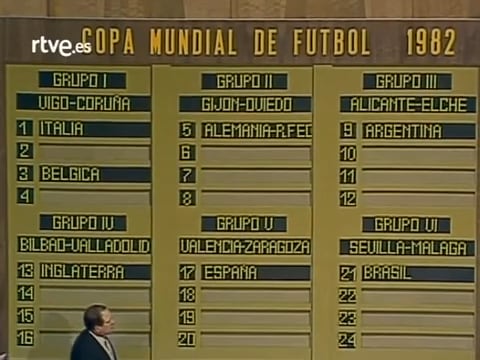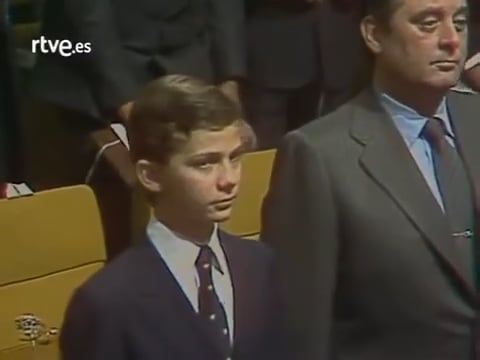
In the early days of 1982, the draw for the World Cup was held in Spain, a tournament that was left in everyone's memory because it was the first one played by Diego Armando Maradona with the Argentine team of César Luis Menotti, who had just won his first title four years ago. Despite the premiere of Pelusa, the reigning champions disappointed and did not reach final instances.
Goalscorer Paolo Rossi's Italy was crowned after beating Federal Germany 3-1 in the final at Santiago Bernabeu, one of the 17 stadiums used during the competition, in what was the world championship with the highest number of venues of all time. But, beyond football, and other color stories that occurred during the competition, the clock marked that on January 16 of that same year, what for many was the worst draw in memory was held.
The Spaniards lived in a time of full democracy. Already without features of the dictatorial regime of Francisco Franco, which lasted for more than four decades until 1977, several years ago the reign of Juan Carlos I had begun. And it was precisely his young son, the then Prince of Asturias Philip -he was 13 years old-, one of the main attractions of a gala that was organized in the Palace of Asturias the Madrid Congresses.
The books say that more than 500 million people followed the images of a draw that was total chaos on TV. After the speeches and mentions at the start of the event, the main table of the event had Pablo Porta (president of the Spanish Federation), the then FIFA boss, the Brazilian Joao Havelange and two other important faces: Hermann Neuberger (president of the Organizing Committee) and that of Joseph Blatter, the one at that time moment general secretary of the entity that governs the destinies of football in the world.
One of the milestones of that World Cup in Iberian territory was that, for the first time, 24 teams formed the top men's football competition. Divided into six groups of four teams, the first conflict arose with the election of the last seed, another of the renewed measures taken by FIFA.
Until the day of the draw, there were five national teams that had their place assured: Italy, Germany, Brazil, Argentina (the last champion) and Spain (as the organizing country) already knew that they would lead the zones. And the rest? Despite the fact that other teams such as Belgium (European runner-up) or Poland (finished third) reached the 12th edition of the World Cup with the best present, FIFA handpicked that England would be the sixth seeded. The reasons? They were the only ones who, except for the chosen ones, had been world champions among the qualifiers (1966).
With the distribution defined, the organization chose to use the drums of the Spanish Lottery and the young people of San Ildefonso, a tradition that surrounds Christmas draws and in which children sing the numbers that are drawn for the famous Christmas Gordo. Thus, it had been defined that there would be a criterion for the South American teams not to cross. That is why in Pot 3, made up of Belgium, Scotland, France, Northern Ireland, Chile and Peru, the latter two were going to be introduced into the bowls once the first two balls that were destined for the group of Argentina and Brazil were removed, in that order.
Faced with this scenario, with the characteristics of the draw defined before the balls started to run, there were problems from the start. The first ball to come out contained the Belgian flag and was placed in Group 1. The second one that appeared was that of Scotland, which was added to the area of Argentina. But when the third mini ball Tango - the shapes that the balls had - was carried by one of the young men, when they reached the stand where the authorities were, Blatter and the rest realized the mistake and had to explain what had happened. “This was the hype of the controversy, we had already announced it,” said Mari Carmen Izquierdo during the TV broadcast about the embarrassment that had just happened.


Thus, without new ball draws, the flaw was patched on the old electronic poster and the Argentine national team, the top seed of Group III, appeared alongside Belgium, while in the VI he joined the Scots with Brazil.
After the delays, which generated whistles and murmurs among the fans present, the draw continued. Until another setback caused long faces among the kings who dominated football at that time. While the giant bolilleros continued their march, one of the Tango balls got stuck - it was the Honduran ball - and broke in half. As the images of the time show, the official broadcast by Spanish Television (TVE) tried to change the shot until the fault was solved.
But that wasn't the only time a ball broke. “The ball stopped, the ball that comes for the group from Spain stopped”, they repeated again on TV when another of the balls got stuck and they had to use a wooden stick to remove it from those immense bolilleros.
While one of the people in charge was trying to get the fragment out, several of the young people from the San Ildefonso school couldn't help laughing out loud at another of the mistakes that marked the 82 World Cup draw forever. The faces of FIFA, including Neuberger's, could not help but be uncomfortable in the face of the recurring problems they suffered during the almost 30 minutes that the World Cup draw lasted.

“Perplexed not knowing what to do, someone has given them a hand,” concluded the Spanish television commentator about the definition of the ball that contained the paper with the flag of Austria, a European team that imaginarily traveled to the area of Federal Germany.
In this way, despite the suffering, the 1982 World Cup completed its group stage picture, which was formed as follows: Group I, which was played at the venues in Vigo and La Coruña, consisted of Italy, Poland, Peru and Cameroon; while Group II was made up of Federal Germany, Algeria, Chile and Austria (Gijon-Oviedo).
In the case of Group III, the protagonists were Argentina, Belgium, Hungary and El Salvador (Alicante and Elche), followed by the IV with controversial England as the top series alongside France, Czechoslovakia and Kuwait (Bilbao-Valladolid). Already in zone V, the local Spain participated accompanied by Honduras, Yugoslavia and El Salvador (Valencia-Zaragoza) and the VI was left with Brazil, the Soviet Union, Scotland and New Zealand (Seville-Malaga).
In Spain 82 was the last time that the second-stage format was played, in which the best two from each group qualified to an instance in which four other areas of three selected were assembled, in which the winners of these crosses stopped for the semifinals and subsequent World Cup final.
40 years ago, the world saw Maradona for the first time in a world championship event. Also to the remembered Verdeamarela of Zico, Cerezo, Batista, Socrates and other glories that could not make it to the final. Another world football icon like Karl-Heinz Rummenigge could not lead the Germans to a new title that went to the Italians who broke through the hand of their goalscorer Paolo Rossi and with the genius of Dino Zoff in the goal.

KEEP READING:
Últimas Noticias
Debanhi Escobar: they secured the motel where she was found lifeless in a cistern
Members of the Specialized Prosecutor's Office in Nuevo León secured the Nueva Castilla Motel as part of the investigations into the case

The oldest person in the world died at the age of 119
Kane Tanaka lived in Japan. She was born six months earlier than George Orwell, the same year that the Wright brothers first flew, and Marie Curie became the first woman to win a Nobel Prize

Macabre find in CDMX: they left a body bagged and tied in a taxi
The body was left in the back seats of the car. It was covered with black bags and tied with industrial tape
The eagles of America will face Manchester City in a duel of legends. Here are the details
The top Mexican football champion will play a match with Pep Guardiola's squad in the Lone Star Cup

Why is it good to bring dogs out to know the world when they are puppies
A so-called protection against the spread of diseases threatens the integral development of dogs




